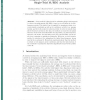Free Online Productivity Tools
i2Speak
i2Symbol
i2OCR
iTex2Img
iWeb2Print
iWeb2Shot
i2Type
iPdf2Split
iPdf2Merge
i2Bopomofo
i2Arabic
i2Style
i2Image
i2PDF
iLatex2Rtf
Sci2ools
IPMI
2007
Springer
2007
Springer
Adaptive Time-Frequency Models for Single-Trial M/EEG Analysis
Abstract. A new method is introduced for estimating single-trial magnetoor electro-encephalography (M/EEG), based on a non-linear fit of timefrequency atoms. The method can be applied for transient activity (e.g. event-related potentials) as well as for oscillatory activity (e.g. gamma bursts), and for both evoked or induced activity. In order to benefit from all the structure present in the data, the method accounts for (i) spatial structure of the data via multivariate decomposition, (ii) time-frequency structure via atomic decomposition and (iii) reproducibility across trials via a constraint on parameter dispersion. Moreover, a novel iterative method is introduced for estimating the initial time-frequency atoms used in the non-linear fit. Numerical experiments show that the method
Initial Time-frequency Atoms | IPMI 2007 | Medical Imaging | Non-linear Fit | Time-frequency Structure |
| Added | 16 Nov 2009 |
| Updated | 16 Nov 2009 |
| Type | Conference |
| Year | 2007 |
| Where | IPMI |
| Authors | Christian Bénar, Maureen Clerc, Théodore Papadopoulo |
Comments (0)

